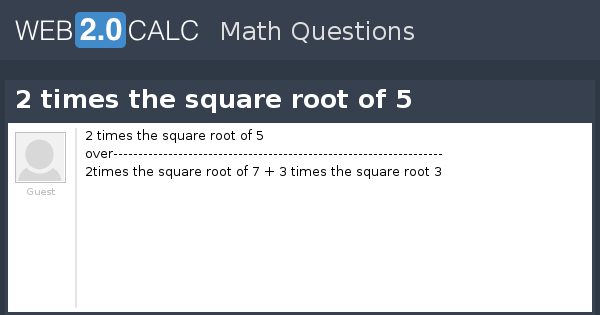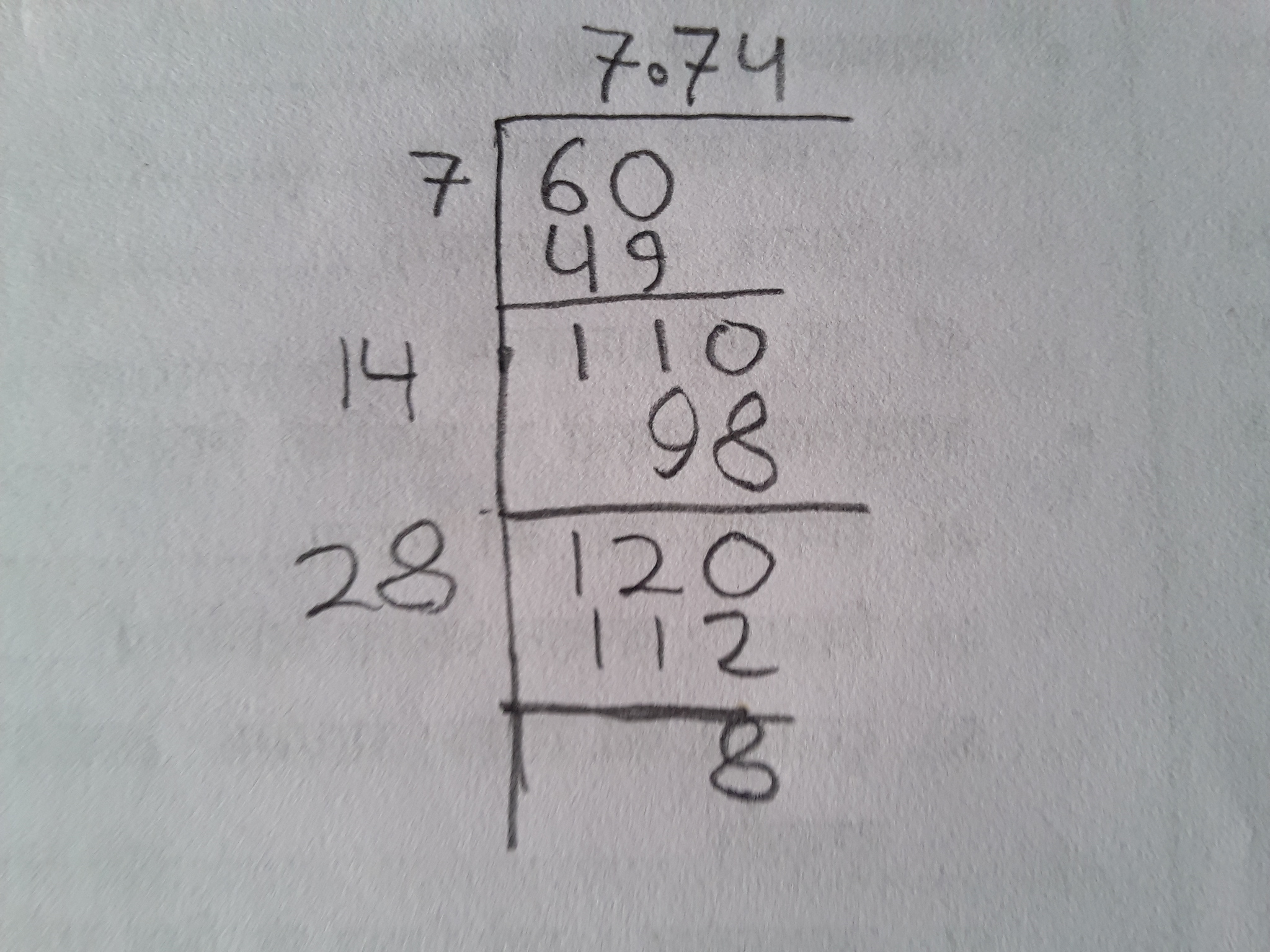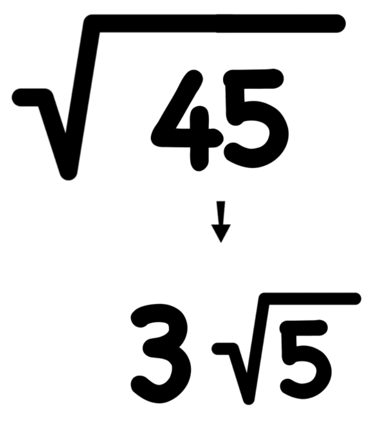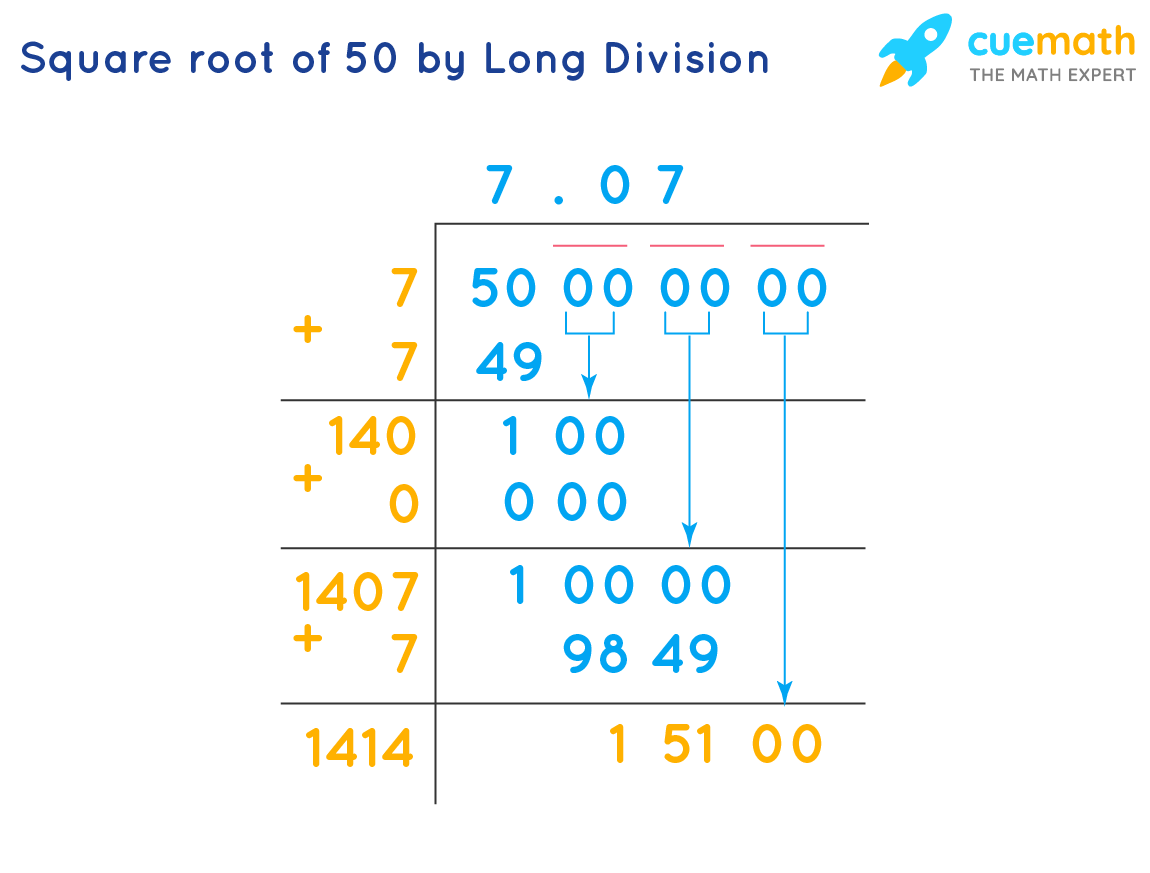Topic what is square root of 50 simplified: Discover how to simplify the square root of 50 with this comprehensive guide. We explore different methods to find the simplified form, including prime factorization and long division. Learn the properties, practical applications, and the significance of this mathematical concept in various fields.
Table of Content
- Simplifying the Square Root of 50
- Introduction to Square Roots
- Understanding the Square Root of 50
- Methods to Simplify the Square Root of 50
- Simplified Radical Form of Square Root of 50
- Decimal Representation
- Is the Square Root of 50 a Rational Number?
- Visualizing the Square Root of 50
- Practical Applications of the Square Root of 50
- Frequently Asked Questions
- YOUTUBE:
Simplifying the Square Root of 50
The square root of 50 can be simplified using various methods. The most common methods include prime factorization and the long division method. Below, we explain these methods in detail and provide the simplified form of the square root of 50.
Prime Factorization Method
Prime factorization involves breaking down 50 into its prime factors:
- 50 can be expressed as \( 50 = 25 \times 2 \)
- Since 25 is a perfect square, \( 25 = 5^2 \)
- Therefore, \( 50 = 5^2 \times 2 \)
Taking the square root of both sides, we get:
\[
\sqrt{50} = \sqrt{5^2 \times 2} = 5\sqrt{2}
\]
Long Division Method
Another way to find the square root of 50 is using the long division method:
- Start by pairing the digits of 50 from right to left. Since 50 has two digits, the first pair is "50".
- Find the largest number whose square is less than or equal to 50. In this case, it is 7, because \( 7^2 = 49 \).
- Subtract 49 from 50, which gives 1. Bring down a pair of zeros to get 100.
- Double the divisor (7) to get 14. Find a number \( X \) such that \( 14X \times X \leq 100 \). The number is 0, giving a new dividend of 1000.
- Continue this process to get more decimal places of the square root. The result will be approximately 7.071.
Simplified Form
The simplified radical form of the square root of 50 is:
\[
\sqrt{50} = 5\sqrt{2}
\]
In decimal form, this is approximately 7.071.
Properties of the Square Root of 50
| Radical Form | \(\sqrt{50} = 5\sqrt{2}\) |
| Decimal Form | 7.071 |
| Type of Number | Irrational |
Conclusion
The square root of 50 simplifies to \( 5\sqrt{2} \) and is approximately 7.071 in decimal form. This value is an irrational number and cannot be expressed as a simple fraction.

READ MORE:
Introduction to Square Roots
The concept of square roots is fundamental in mathematics and is essential for solving various algebraic equations. A square root of a number is a value that, when multiplied by itself, gives the original number. For example, the square root of 25 is 5 because \(5 \times 5 = 25\). In mathematical notation, the square root of a number \(x\) is written as \(\sqrt{x}\).
Square roots can be categorized into perfect squares and non-perfect squares. Perfect squares are numbers whose square roots are whole numbers. For instance, 1, 4, 9, 16, and 25 are perfect squares. Non-perfect squares, such as 2, 3, 5, 7, and 50, do not have whole numbers as their square roots. Instead, their square roots are irrational numbers, which means they cannot be expressed as a simple fraction and have non-repeating, non-terminating decimal expansions.
Understanding how to simplify square roots is crucial for various applications in geometry, physics, engineering, and beyond. Simplifying a square root often involves breaking down the number into its prime factors and using the properties of square roots to express them in a simpler form.
Here’s a step-by-step approach to simplifying square roots:
- Prime Factorization: Break down the number into its prime factors.
- Pairing: Identify and pair the prime factors.
- Simplification: Move pairs of prime factors outside the square root symbol.
For example, to simplify the square root of 50, follow these steps:
- Prime factorize 50: \(50 = 2 \times 5^2\).
- Pair the prime factors: \(5^2\) can be paired as \(5\).
- Simplify: \(\sqrt{50} = \sqrt{2 \times 5^2} = 5\sqrt{2}\).
By mastering these steps, you can simplify any square root, making it easier to work with in mathematical equations and real-world applications.
Understanding the Square Root of 50
The square root of 50 is an interesting mathematical concept. It involves finding a number which, when multiplied by itself, equals 50. This is expressed as √50. Since 50 is not a perfect square, its square root is an irrational number, meaning it cannot be expressed as a simple fraction and has an infinite, non-repeating decimal expansion.
To simplify the square root of 50, we can break it down into its prime factors. This involves expressing 50 as a product of its prime factors:
- 50 = 2 × 5 × 5
We can then use the property of square roots which states that √(a × b) = √a × √b. Applying this to our factors, we get:
√50 = √(2 × 5 × 5) = √2 × √(5 × 5) = √2 × 5 = 5√2
This shows that the simplified form of √50 is 5√2.
For practical purposes, the decimal approximation of √50 is about 7.071. This can be calculated using a calculator or by using the long division method for finding square roots.
To further understand the applications and implications of the square root of 50, consider the following points:
- Irrational Number: √50 is an irrational number because it cannot be precisely represented as a fraction.
- Simplification: Simplifying √50 to 5√2 makes it easier to handle in mathematical expressions and calculations.
- Applications: The square root of 50 can be used in various contexts, such as in geometry to find the diagonal length of a square with an area of 50 square units, or in physics to calculate magnitudes in vector problems.
Understanding these aspects helps in appreciating the importance and utility of the square root of 50 in different mathematical and real-world scenarios.
Methods to Simplify the Square Root of 50
Simplifying the square root of 50 involves breaking it down into its prime factors and expressing it in a simpler radical form. Here are the detailed steps to simplify √50:
- Identify the prime factors of 50. The prime factorization of 50 is 2 × 5 × 5.
- Group the prime factors in pairs: 50 can be expressed as 2 × 5².
- Rewrite the square root of 50 using these pairs: √50 = √(2 × 5²).
- Apply the property of square roots that allows you to separate the terms: √50 = √2 × √5².
- Simplify further by taking the square root of the perfect square (5²): √50 = √2 × 5.
Thus, the simplified form of the square root of 50 is 5√2. This step-by-step method ensures that you accurately simplify the radical expression.
Simplified Radical Form of Square Root of 50
The square root of 50 can be simplified by expressing 50 as the product of its prime factors. This method helps in simplifying the radical to its simplest form, making calculations easier and avoiding errors. Here's a step-by-step guide to simplifying the square root of 50:
First, express 50 as a product of its prime factors: \(50 = 2 \times 25\). Since 25 is a perfect square, it can be written as \(25 = 5^2\). Thus, we can write 50 as:
\(50 = 2 \times 5^2\)
Next, take the square root of both sides:
\(\sqrt{50} = \sqrt{2 \times 5^2}\)
Using the property of square roots, \(\sqrt{a \times b} = \sqrt{a} \times \sqrt{b}\), we can separate the square root of the product:
\(\sqrt{50} = \sqrt{2} \times \sqrt{5^2}\)
Simplify further by calculating the square root of 25, which is 5:
\(\sqrt{50} = \sqrt{2} \times 5 = 5\sqrt{2}\)
Therefore, the simplified radical form of the square root of 50 is \(5\sqrt{2}\). This simplified form is useful in various mathematical calculations and provides a more straightforward representation of the square root.

Decimal Representation
The square root of 50, denoted as √50, is an irrational number, meaning it cannot be expressed as a simple fraction and its decimal representation is non-terminating and non-repeating. However, it can be approximated to a certain number of decimal places for practical purposes.
To find the decimal representation of √50, you can use a calculator or employ methods such as the long division method for square roots. Here, we provide the decimal approximation:
√50 ≈ 7.071067811865475
This approximation can be rounded to various decimal places depending on the required precision:
- To 1 decimal place: 7.1
- To 2 decimal places: 7.07
- To 3 decimal places: 7.071
- To 4 decimal places: 7.0711
- To 5 decimal places: 7.07107
The decimal representation can be extended further as needed, but for most practical purposes, rounding to a few decimal places is sufficient. Below is a table illustrating the square root of 50 rounded to various decimal places:
| Decimal Places | Approximation |
|---|---|
| 1 | 7.1 |
| 2 | 7.07 |
| 3 | 7.071 |
| 4 | 7.0711 |
| 5 | 7.07107 |
Using a calculator or software tool, the precision can be increased to obtain more decimal places. For most calculations, however, an approximation to four or five decimal places is typically sufficient.
Is the Square Root of 50 a Rational Number?
To determine if the square root of 50 is a rational number, we first need to understand the definition of rational numbers. A rational number is any number that can be expressed as the quotient or fraction \( \frac{p}{q} \) of two integers, where \( p \) and \( q \) are integers and \( q \) is not zero.
Now, let's analyze the square root of 50:
- Prime Factorization: The prime factorization of 50 is \( 2 \times 5^2 \). Using this, the square root of 50 can be simplified as: \[ \sqrt{50} = \sqrt{2 \times 5^2} = 5\sqrt{2} \]
- Simplified Form: The simplified form \( 5\sqrt{2} \) indicates that √50 is not a whole number, as \( \sqrt{2} \) is an irrational number.
- Irrational Numbers: An irrational number cannot be written as a simple fraction. The number \( \sqrt{2} \) is known to be irrational, meaning it cannot be expressed as \( \frac{p}{q} \) where both \( p \) and \( q \) are integers.
- Conclusion: Since \( \sqrt{50} = 5\sqrt{2} \) includes the irrational number \( \sqrt{2} \), the square root of 50 itself must also be irrational. Therefore, it cannot be expressed as a fraction of two integers.
Based on the above analysis, we conclude that the square root of 50 is not a rational number. It is an irrational number because it cannot be expressed as a ratio of two integers.
| Property | Details |
|---|---|
| Prime Factorization | \( 2 \times 5^2 \) |
| Simplified Form | \( 5\sqrt{2} \) |
| Rational or Irrational | Irrational |
| Reason | Includes \( \sqrt{2} \), which is irrational |
Visualizing the Square Root of 50
Visualizing the square root of 50 can help in understanding its value and significance. There are several methods to visualize and comprehend √50:
- Number Line Representation:
One of the simplest ways to visualize √50 is by placing it on a number line. Since √50 is approximately 7.071, it lies between the integers 7 and 8. More precisely, it is slightly above 7:

- Geometric Interpretation:
Consider a square with an area of 50 square units. The length of each side of the square is equal to √50. To visualize this, you can imagine constructing a square where each side is 5√2 units long, since:
\[
\sqrt{50} = 5\sqrt{2}
\]This geometric approach helps in understanding the spatial aspect of √50.

- Graphical Representation:
On a graph, the square root function \( y = \sqrt{x} \) can be plotted. The point where \( x = 50 \) gives the value of \( y \) as √50. This visualization shows the continuous nature of the square root function:

By using these visual methods, you can gain a better understanding of the magnitude and properties of the square root of 50. Whether on a number line, through geometric shapes, or via a graph, visualizing √50 makes it easier to comprehend and apply in various mathematical contexts.
Practical Applications of the Square Root of 50
The square root of 50, simplified as \( 5\sqrt{2} \), finds its application in various fields and real-world scenarios. Here are some practical applications:
- Geometry and Construction:
In geometry, the square root of 50 can be used to calculate distances and dimensions. For example, if you are constructing a square with an area of 50 square units, the length of each side will be \( \sqrt{50} \) units. This is important for architectural designs and construction projects where precise measurements are crucial.
- Engineering:
Engineers often encounter the square root of 50 in various calculations, such as determining the diagonal length of a rectangular component with sides of different lengths. For instance, if a rectangle has sides of lengths \( 5 \) units and \( 5\sqrt{2} \) units, the diagonal length can be calculated using the Pythagorean theorem:
\[
\text{Diagonal} = \sqrt{(5)^2 + (5\sqrt{2})^2} = \sqrt{25 + 50} = \sqrt{75} = 5\sqrt{3}
\] - Physics:
In physics, the square root of 50 may appear in formulas related to waves, oscillations, and other phenomena. For example, calculating the resultant amplitude of two perpendicular waves of equal amplitude can involve the square root of 50 when their amplitudes are combined vectorially.
- Mathematics:
In various mathematical problems, such as solving quadratic equations or simplifying expressions, the square root of 50 often appears. Knowing its simplified form \( 5\sqrt{2} \) helps in algebraic manipulations and finding exact solutions.
- Computer Graphics:
In computer graphics, calculating distances between points in a 2D or 3D space may involve the square root of 50. For example, if two points are separated by a horizontal distance of 5 units and a vertical distance of \( 5\sqrt{2} \) units, the Euclidean distance between them is \( \sqrt{50} \).
These applications demonstrate the versatility of the square root of 50 in various practical and theoretical contexts. Understanding its value and properties can greatly enhance problem-solving skills in different disciplines.
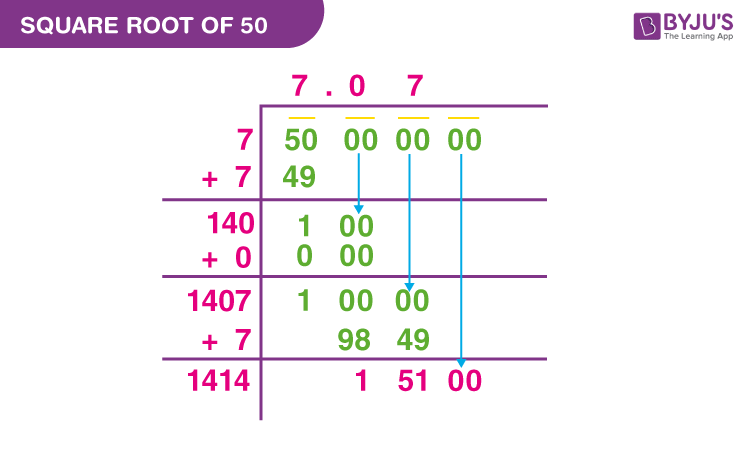
Frequently Asked Questions
Here are some frequently asked questions about the square root of 50, along with detailed answers:
- What is the square root of 50?
The square root of 50 is a number which, when multiplied by itself, equals 50. It is denoted as \( \sqrt{50} \) and is approximately equal to 7.071.
- How do you simplify the square root of 50?
To simplify the square root of 50, you factorize 50 into its prime factors and look for pairs of prime numbers:
\[
\sqrt{50} = \sqrt{2 \times 5^2} = 5\sqrt{2}
\] - Is the square root of 50 a rational number?
No, the square root of 50 is not a rational number. It is an irrational number because it cannot be expressed as a simple fraction \( \frac{p}{q} \) where \( p \) and \( q \) are integers.
- What is the decimal representation of the square root of 50?
The square root of 50 in decimal form is approximately 7.071067811865475. This is a non-terminating and non-repeating decimal, typical of irrational numbers.
- Can the square root of 50 be simplified further?
The simplest radical form of the square root of 50 is \( 5\sqrt{2} \). It cannot be simplified further because \( \sqrt{2} \) is already in its simplest form.
- How is the square root of 50 used in real life?
The square root of 50 is used in various fields such as geometry, engineering, physics, and computer graphics. It helps in calculating distances, dimensions, and solving mathematical problems involving roots.
- What are some properties of the square root of 50?
Some key properties of the square root of 50 include:
- It is an irrational number.
- Its simplified form is \( 5\sqrt{2} \).
- It has a non-terminating, non-repeating decimal expansion.
- It can be visualized geometrically and graphically.
Cách Đơn Giản Hóa Căn Bậc Hai Của 50: Sqrt(50)
READ MORE:
Đơn Giản Hóa Căn Bậc Hai Của Một Số | Đơn Giản Hóa Toán Học, Căn(50)








